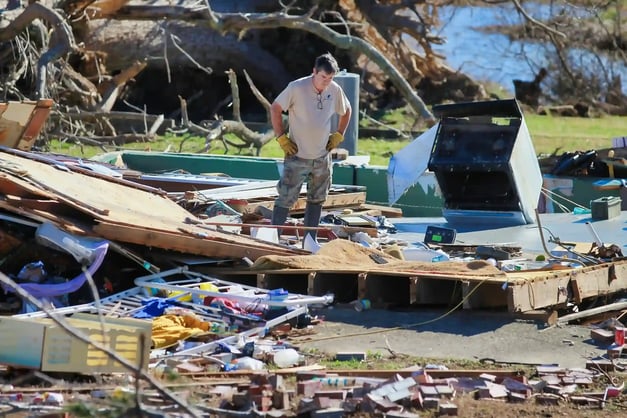Sinking Values: How climate risk is reshaping the housing market
By Mana Starosta
From extreme heat to deadly storms, the changing climate is wreaking havoc on our infrastructure and testing the resilience of our towns and cities. The immediate impact is made painfully evident in the wreckage left behind by increasingly common floods, hurricanes, coastal inundations, wildfires, and earthquakes - not to mention the tragic loss of life.
Less visible is the long-term impact of climate instability on the property market. Even before disaster strikes, households are facing rising insurance premiums, declining property values, reduction or loss of insurance coverage, and shrinking options for affordable housing - all as a result of climate risk.

A topography of vulnerability
In Australia, a recent climate risk assessment found that under a 3°C warming scenario, Australian property values could take a hit of $571 billion by 2030 before reaching $611 billion by 2050. This number represents the aggregated sum of the home value lost all across the country due to flood risk and increased premiums. The study drew on findings that 1.5 million homes in Australia were “currently located in “high risk” areas for floods, bushfires, tropical cyclones and heatwaves”.
Halfway across the world, a study by Bayes Business School’s Real Estate Research Centre found that 4 million British homes were currently in areas of medium or high flood risk.
In the US, a study by Cotality found that “more than 33 million U.S. homes are at risk of hurricane wind damage this year, with a combined $12 trillion in reconstruction value”.
All this makes one thing clear: climate risk is fundamentally reshaping the housing and insurance landscape and the numbers are staggering. A new topography of risk is surfacing, creating areas that are vulnerable to coverage loss, premium hikes, and other cascading effects that affect both insurers and homeowners.
For example, in Florida, since 2020, 15 property insurers have declared insolvency and in 2022, insurers paid 50% more in payouts compared to the average yearly payout in the 2010s. Meanwhile in Miami’s 100-year flood zone, properties have declined by up to 18% per square foot.
“High risk” areas are not created equal
As with many climate-induced challenges, economically disadvantaged groups are hit the hardest. Living in “higher risk” areas already implies greater exposure to climate risk, but research shows that low-income homeowners are impacted the most by homes becoming uninsurable and un-mortgageable as a result of flood risk.
When researchers modelled the yearly cost of damage repairs (correlated with higher premiums) they found that low-income homeowners in flood-prone areas faced higher yearly costs than higher income neighbours. This asymmetry was projected to worsen in the future, and with low-income households less able to relocate, they are at risk of becoming what the report called “climate prisoners” - trapped in uninsurable, unsafe homes. Furthermore, with homes losing value and insurance premiums rising, homeowners are struggling to keep up with their mortgage payments leading to rising foreclosures.
The ability to purchase a home in the first place is also affected by climate risk, with insurers retreating from high-risk areas or raising their rates. Unable to access insurance, the ability to qualify for a mortgage is affected, significantly impacting homeownership in coastal areas. The supply of affordable housing, and affordable rentals in particular, is also reduced due to the greater likelihood that they are rendered uninhabitable by disasters.
_11zon.jpg?width=627&height=470&name=evelyn-geissler-m7kjX78P_kQ-unsplash%20(1)_11zon.jpg)
Building resilience before disaster strikes
Avoiding worst-case climate scenarios must remain a global priority, and enhancing local resilience is part of that effort. That means strengthening both the physical structures we live in and the policies that govern housing and insurance.
Building more resilient housing can look like an apartment with a green roof that increases biodiversity, mitigates urban heat island effects, and absorbs rainwater to minimise flood risk or roof clips that make homes more resistant to wind. The most effective solutions are tailored to local contexts and crucially, they are accessible to those who need it most.

Resilience necessitates taking action before disaster strikes. The foundation of effective planning is reliable, comprehensive data on risk. Whether it’s insurers pricing flood risk, prospective buyers reviewing a property’s flood history, or governments revising land-use policies, accessible information is key. Public flood risk maps, extreme weather–water models, and climate event forensics all play a vital role in guiding adaptation strategies. These strategies must encompass wider structural changes like implementing insurance reform and updating lending models.
Many of these changes are by no means easy, but what underscores all of these challenges is the importance of recognising risk and understanding how disasters affect different communities and landscapes. Resilience doesn’t end at responding to the next storm or flood, it starts with building the infrastructure, policies, and systems needed to withstand the long-term consequences that follow.
Nature-related Regulations Worldwide
By Charles Bouqueuniaux
Nature-related regulations worldwide are becoming increasingly ambitious, integrated, and forward-looking, reflecting a growing recognition of the urgency to address biodiversity loss, climate change, and ecosystem degradation.
Internationally, the Kunming–Montreal Global Biodiversity Framework (KMGBF) represents a pivotal commitment by 196 countries to halt and reverse biodiversity loss by 2030.
It sets clear targets, including protecting 30% of land and oceans and restoring degraded ecosystems. Complementing this, the Taskforce on Nature-related Financial Disclosures (TNFD) framework is encouraging companies to integrate nature-related risks into financial decision-making, signaling a structural shift that links environmental protection with financial markets.
Regional and national actions mirror these global ambitions. In the European Union, the Nature Restoration Law, the first of its kind, sets binding targets to restore at least 20% of degraded ecosystems by 2030 and all requiring restoration by 2050.
Additionally, the revised Environmental Crime Directive (ECD) imposes stricter penalties for environmental offenses, including illegal deforestation and waste trafficking, reflecting a commitment to stronger enforcement.
In the United Kingdom, Biodiversity Net Gain (BNG) requirements make it mandatory for new developments to demonstrate a measurable positive impact on biodiversity. Alongside this, a Statutory Environmental Plan is being developed to deliver long-term restoration targets under the Environment Act.
The direction of travel is clear. Policies are becoming more integrated, linking climate and nature goals within unified strategies. There is a rising emphasis on private sector accountability, with frameworks like TNFD and BNG pushing businesses to actively contribute to restoration goals.
Governments are also increasingly recognizing the economic value of nature, as highlighted in studies like the Dasgupta Review, influencing policy and investment decisions. Meanwhile, stricter enforcement through legal instruments like the EU’s ECD signals a commitment to deter environmental crimes.
Finally, a fundamental shift is occurring from passive conservation to active ecosystem restoration, positioning nature as central to sustainable economic and social development.
Team Spotlight: Gentian Showcases Nature Risk Platform at Sustainable Ventures’ Exclusive Event to Norwegian Delegation
By Charles Bouqueuniaux
Last week, Gentian was honoured to be one of three start-ups selected to present at an exclusive event hosted by Sustainable Ventures, welcoming a high-level delegation of Norwegian organisations, including several of the country’s leading financial institutions.
Thomas Fenal, Gentian’s Chief Strategy Officer, introduced the company’s scalable habitat mapping platform, showcasing its applications for biodiversity risk screening at scale, a growing priority as financial institutions look to understand nature-related impacts across their portfolios.
.jpg?width=1600&height=1055&name=unnamed%20(2).jpg)
In a joint session, Samuel Knight, Gentian’s Head of Sales, joined forces with partners from SkenarioLabs to present a combined solution tailored for the financial sector.
Their presentation demonstrated how enhanced nature and risk data enables institutions to identify ecological risks linked to physical assets, aligning with TNFD frameworks and broader ESG disclosure requirements.
As physical climate and nature risks increasingly shape investment decisions, the audience’s strong engagement highlighted a shift in capital markets, with nature emerging as a central concern in portfolio management and capital allocation.
Gentian extends thanks to Sustainable Ventures for convening such a forward-thinking group of changemakers and looks forward to continued collaboration on nature-positive finance.
More from Gentian:
-
The Essential Role of Biodiversity Data for Robust ESG Reporting
-
Demystifying Biodiversity Metrics: A Guide to IUCN, UKHab, and EUNIS with Satellite AI
-
Tailoring Biodiversity Solutions for Every Project Size
We invite you to join us as we navigate this critical space and share knowledge that empowers action. To receive Field Notes directly in your inbox, sign up via the form below:
.png?width=1600&height=1000&name=Field%20Notes%20Logo%20(White%20background).png)

.jpg?width=400&height=250&name=20240918_131133%20(1).jpg)